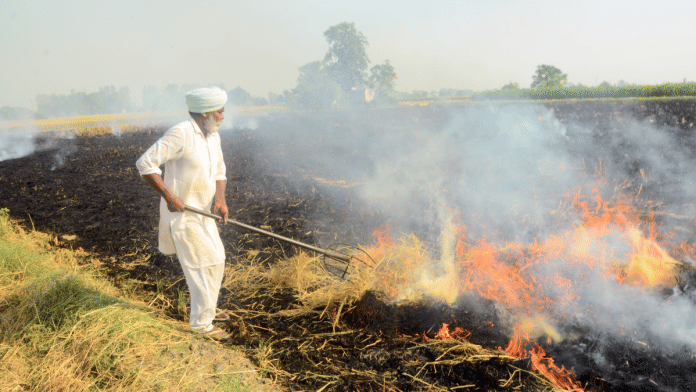New Delhi: With the rice harvesting season round the corner, the Punjab and Haryana governments are gearing up for the challenges that come annually with stubble burning, which contributes significantly to air pollution across northern India.
To combat this, a report by the Bengaluru-based Center for Study of Science, Technology, and Policy (CSTEP)—Stubble Management: Harnessing Ex-Situ Options and Market Mechanisms, released on 28 August—recommends incentivising large and medium-scale farmers to adopt ex-situ stubble management systems.
These recommendations are particularly urgent as stubble burning continues to exacerbate respiratory illnesses in Delhi and other northern regions, despite ongoing government interventions. In the 2022-2023 Kharif season, Punjab—the primary contributor—recorded 36,663 farm fire incidents, marking a 27 percent decline from the previous year, but still far from meeting the state’s net zero target.
The report intends to help Punjab better meet targets set by the Punjab Pollution Control Board to consume nearly 5.96 million tonnes of rice straw in 2024 through ex-situ methods. These approaches could include utilising stubble for energy generation in industries, such as compressed biogas plants, biomass-based power plants, brick kilns, and thermal power plants.
Also read: What is Great Nicobar project, and why are Bhupender Yadav and Jairam Ramesh butting heads over it
Subsidise costs to alleviate financial burden on farmers
Based on the 2021 report by the Council on Energy, Environment, and Water (CEEW), Delhi, a farmer typically spends between Rs 1,500 and 1,800 per tonne to transport the stubble from the farm to the industrial-end users, either directly or via intermediaries. These costs go further up between Rs 3,000 and 6,000 per tonne if the stubble is transported to the enterprises in the form of bales, briquettes, or pellets to meet energy demands.
The CSTEP report recommends the government to subsidise costs to alleviate the financial burden on farmers, particularly through an upfront payment.
The report—which was shared during the India Clean Air Summit (ICAS) in Bengaluru by Adarsh Pal Vig, Chairman of the Punjab Pollution Control Board—also emphasises the importance of targeting medium and large-scale farmers, who account for 66 percent of land ownership in Punjab and are the primary contributors to stubble burning in the region.
According to the report, these farmers with greater than 4 hectares (ha) of farmland, along with support from the government, are well-placed to adopt and implement these policy changes for stubble management.
CEEW experts have projected increased uptake of ex-situ methods among the farmers of Punjab. Meanwhile, the high bale delivery costs at Rs 2,500-3,000 per tonne for a distance of 50 km act as a dampener, according to the think tank’s estimates.
“We see that ex-situ straw management is gaining popularity, with over 33 percent of Punjab’s farmers opting for the method, as per the CEEW’s study. However, the scaling up of the sector is possible only by increasing the number of biomass collection and transportation machines and storage infrastructure,” said L.S. Kurinji, Programme Associate, CEEW.
She added that the Centre has rolled out financial incentives to procure biomass handling machines and establish biomass collection depots from 2023 onwards.
“State authorities must publicise these initiatives through targeted outreach for quicker onboarding of prominent industry players and farmer groups,” Kurinji stated.
Also read: Indian women missing from climate change action. $5 trillion goal is impossible without them
Strengthen supply chain infrastructure
According to the report, the districts of Patiala, Bathinda, Mansa, Tarn Taran, Amritsar, and Sangrur—with 110, 105, 96, 101, 155, and 135 brick kilns, respectively—and the nearby thermal power plants, form a key part of the Punjab’s industrial cluster.
To address the stubble burning issue, the government must strengthen the supply chain infrastructure, including straw banks, which collect and store stubble, and pelletisation units, which convert stubble into usable pellets. Expanding these facilities through public-private partnerships could improve the current limited network, as the report indicates.
The report also emphasises that Punjab requires a minimum of 1,320 straw banks distributed throughout the state and 165 pelletisation units—mainly situated near thermal power plants, brick kilns, and industries—to effectively process stubble and meet the state’s high demand for 3 million tonnes of stubble pellets using ex-situ methods.
(Edited by Tarannum Khan)
Also read: How Tripura deluge has exposed chinks in India’s flood prevention mechanism






